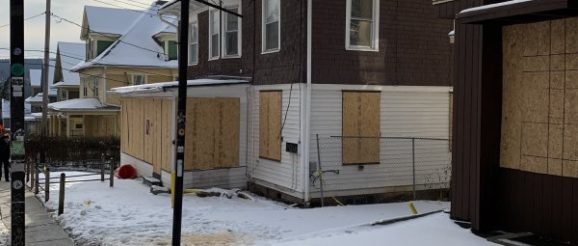As houses are prepped for demolition, developers plan Collegetown “Innovation District”

ITHACA, N.Y. — It’s a rather unusual sight in the heart of Collegetown. One after another, old student apartment houses boarded up, their utilities cut off. One could be forgiven for thinking that, with the students at home for their holiday break, the neighborhood was abandoned like a gold mining town after the vein’s tapped out.
But that’s not the case. Rather, it’s the first step in a project that’s likely to reshape the Collegetown neighborhood completely, one that developers John Novarr and Philip Proujansky call the “Innovation District”.
The moniker is thrown around so often that there’s a formal definition for such places (which number 80+ worldwide). Using the Wikpedia definition, “Innovation districts are zones in cities where public and private actors work to attract entrepreneurs, startups, business incubators, generally with the aim of revitalizing depressed downtown areas.”
Photo courtesy of Aryeal Jackson.
According to an explanation provided by Proujansky at the Tompkins County Industrial Development Authority’s meeting on December 11th, the one planned for Collegetown would consist of 6 or 7 sites with 10 buildings – one site has yet to be procured, but they expect to close on it shortly. The built-out square footage would be 750,000 to 900,000 square feet, or about four City Centres, to try and give an idea of just how big that is.
Simply put, this is a massive proposal.
“We’re going to be embarking on the planning process with the city, utilizing a PUD, or Planned Unit Development, for construction. The goal is to build concentrations in zoning districts where it is desired, and to use less density in the surrounding districts where the intended use was for lower density. That PUD process is what will essentially create the Innovation District for us…(W)e could build 2,000 bedrooms, but that’s not our goal. We envision having both residential and office over collaboration/academic and retail space, and because we’re taking the PUD process, we have to deliver a number of incentives to the city and to the community, these are incentives that we embrace. We’re local, we support local businesses, we use local contractors, union (labor) almost exclusively, and we envision the same going forward.”
It would not be the first foray into “mega-projects” for Novarr and Proujansky. The pair developed the 1,200+ bed Collegetown Terrace project on the southern edge of Collegetown earlier this decade. used by Cornell for its Executive MBA program and staff office space, and a pair of residential projects, a 24-unit project at 238 Linden Avenue and a 67-unit project finishing up now at 119-125 College Avenue. The duo also serve as development consultants for Cornell’s $175 million, 2,000-bed North Campus expansion currently underway.
The properties being boarded up are on the 100 Block of Catherine Street, the 200 Block of College Avenue and the 300 Block of College Avenue. The seven Catherine Street and 300 Block properties were purchased by Novarr and Proujansky in December 2018 for $15.6 million. The four 200 Block properties (204, 206, 208 and 210 College Avenue) were purchased along with 118 Cook Street for $4.1 million back in 2008. 118 Cook Street was torn down in November in what city planning staff described as “an issue with it that required its demolition”.
So why board them up and tear them down before anything’s approved? Well, to be candid, because they can. This is Novarr and Proujansky’s typical approach to development projects, as seen previously with 209-215 College Avenue (now the Breazzano Center) and 325 College Avenue, which is still vacant with no active proposal before the city planning board. Demolishing beforehand allows the site to be “shovel-ready”, which reduces development risk (it allows for more thorough geotechnical/soil testing) and it gives more flexibility with when construction can start.
As for the “Innovation District”, there has been little that’s been publicly said about the massive proposal. Proujansky stated that the building would adhere to the city’s incoming Green Building Policy and would be powered completely by alternative energies (primarily off-site solar in tandem with geothermal heating and air-source heat pumps), and that the housing, previously expected to be about 300 units and non-student, would be market-rate. The developers plan to create a grant fund to serve non-profits seeking to build affordable housing, primarily in other parts of the city but open to affordable housing projects countywide.
Plus, here’s one other important detail worth noting, especially given the developers’ close relationship to Cornell. “These projects will be on the tax rolls. This community will not survive if these properties were taken off the tax rolls…(W)e’re not coming here asking for an abatement. What are we are going to be seeking is a structured real estate tax model, similar to what we did with the Breazzano,” said Proujansky.
One last thing; while the rumor mill has been working hard, the occupants of that massive amount of space are not clear. “We think we’re going to be bringing some out-of-area businesses to the community, who want proximity to Cornell University, we’ll be bringing in some start-ups,” said Proujansky. “Multi(family) residential will be a minority component.” The first office project would have about 50,000 square feet, and although IDA member and city councilor Laura Lewis asked about job figures, Proujansky was circumspect in providing specifics, only comparing it to the Breazzano and its hundreds of jobs, and noting that Cornell may be a component in the Innovation District. Ballparking, 50,000 square feet is usually about enough for 250-300 workers. “There’s a lot of job creation attached to this,” he added.
Thomas Giery Pudney contributed to this report.
The post As houses are prepped for demolition, developers plan Collegetown “Innovation District” appeared first on The Ithaca Voice.
